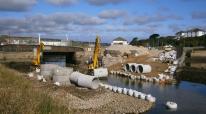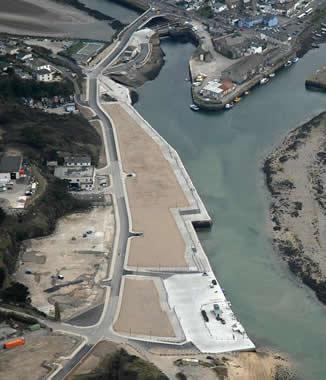
78.4%
Whole Project Award
Project Team
Client: Cornwall Council
Design: Parsons Brinkerhoff
Construction: Carillion Civil Engineering
The Project
The North Quay Infrastructure Project in Hayle, Cornwall is the first significant civil engineering project in the historic town of Hayle since the A30 by-passed the town in 1984. Prior to that the last capital investments in Hayle Harbour were undertaken in 1939. The main aims of the project were primarily to arrest further urban degradation by initially providing a new adopted highway to the proposed Marine Renewables Business Park (where the £42 million Wave Hub control building is situated), to future-proof the quay against rising sea levels, and to be a catalyst for further regeneration within Hayle.

Completed scheme viewed from the north
Necessary infrastructure works included: a new vehicular bridge over Copperhouse Pool a Special Site of Scientific Interest (SSSI); repair works to listed harbour walls on the North, East and Merchant Curnow Quays; the creation of a promenade along North Quay and flood protection works.
The project has had a direct economic impact, not only for Hayle and West Cornwall, but also the region as a whole through opening up the area for further economic development and augmenting Cornwall’s and South West Marine Energy Park’s marine renewables and employment agenda.
With existing Public Rights of Way across North Quay, one of the key challenges to the delivery of the project was to maintain these Rights and ensure that local residents and the community as a whole were considered and consulted with as part of the delivery process. This also included close collaboration and the subsequent relocation of operational businesses within the area of construction activity.
With phase one of the project completed and the new adopted highway and bridge opening up access to Cornwall Council’s Marine Renewables Business Park, an additional £6m of capital investment has been released to enable work to commence on the first phase of development on North Quay in February 2014 which is, as previously stated, the first significant capital investment in Hayle Harbour since 1939!
The public sector urban regeneration investment in North Quay (DBIS, DECC, ERDF and Cornwall Council) will also shortly unlock private sector development on North Quay and also, arguably on viability grounds, has expedited development on Hayle Harbour’s South Quay where redevelopment commenced in October 2013. Furthermore, as was the case with North Quay, a number of historic features on South Quay will be enhanced to preserve links with Hayle’s historic past.
The total cost of the first phase of development on the Hayle North Quay infrastructure project was £17million, including detailed design and project management costs.
In what proved to be an exceptionally challenging project, the scheme initially achieved a “Very Good interim Client and Design Award” in December 2010 which, with committed and dedicated work by the wider team and in spite of personnel changes, elevated the outcome to an “Excellent” Whole Project Award in May 2013.
Challenges faced:
Land Use and Landscape Issues
The footprint of the development lies entirely within a brownfield site. As a result of previous use, excavated substrates were heavily contaminated with heavy metals and hydrocarbons. Materials were retained and managed on site where possible under the supervision of the Environment Agency. Through excellent planning and execution of the materials management plan almost all of the arisings on the site were able to be incorporated into the works with only the most heavily contaminated material being removed and clean material imported. Capping of the development plots was carried out to minimise leachate and improve water quality within the harbour.
The finish to the pre-cast concrete flood wall was agreed with the Town Council, Planners and Conservation Officers to ensure that it fitted with the local landscape and reflected the site’s industrial past. The use of pre-cast materials within such close proximity to the water’s edge reduced the risk of a pollution incident.
The Historic Environment
The use of the site as a working harbour and busy port resulted in several historic features of archaeological importance being discovered on site. Along with the listed quay walls and stable block building, an old railway line with turntable remained as a reminder of the site’s past use, as did several maritime features such as tie-rings, chains and rope anchors. A section of the railway track, along with the turntable was reinstated (in a prominent location) as part of the completed works. The listed quay walls were repaired and re-pointed using materials agreed by the Conservation Officers.
Additional historic features discovered during the works included:
- A ‘rose’ thought to be from a mine drainage pump (probably cast at the nearby Harveys Foundry) which was retained and included in the final project.
- A historic weighbridge which was removed, relocated and set in reclaimed historic NORI red bricks from site.
- Excavation of the North Quay sluice uncovered the original sluice gates thought to have been buried upon the ceasing of the historic sluicing regime. After much discussion it was agreed that the gates should be placed on the St George’s Memorial Walk, situated adjacent to the development site, for all to see an important part of Hayle’s heritage. A previously buried sluice arch and channel has been repaired and remains uncovered for the public to view.

Historic enhancements at sluice with listed stable block and pump rose in far distance
Ecology and Biodiversity
Copperhouse Pool (which forms part of the larger Hayle Estuary and Carrick Glen SSSI) is situated to the south-east of the scheme and is designated for its migratory bird interest. Although the majority of the site had limited ecological value, part of the proposals was to build a vehicular bridge over a corner of the designation.
The project team worked closely with Natural England, RSPB and EA as well as the Ecological Clerk of Works to minimise construction impacts. A temporary causeway was built using large flumes (to take the rapid ebbing and flowing of the tides) and wrapped aggregates to create a platform on which to build the permanent bridge. Water quality (heavy metals), turbidity and aquatic biota were regularly monitored by the Ecological Clerk of Works as were the bird populations throughout construction. A 4 metre high temporary bird screen was erected to minimise disturbance to birds in the estuary whilst the new bridge was being constructed. The completed bridge included a permanent bird screen to mask the movement of cars and pedestrians on the bridge. A dog control order was also placed on the estuary area of Copperhouse Pool to prevent further disturbance to the birds.
Soil containing the rare White Ramping and Purple Ramping Fumitory was retained, carefully stored and monitored during construction. The seed bank was then returned as close to its original location as possible during the landscaping of the scheme where it is hoped the species will flourish once more.
The northern end of the site backs onto a large sand dune system which supports a population of reptiles. During construction, fencing was used to prevent reptiles straying onto site. As an additional enhancement measure a large hibernacula was created at the northern end of the site where the road terminates at the Wave Hub. This will provide additional hibernation habitat for the reptiles on site.

Building the temporary causeway within the Site of Special Scientific Interest
Relations with the Local Community and other Stakeholders
The project enjoyed considerable support from stakeholders and local people, many of whom had only known decay and dereliction in the harbour. The project team worked hard to build strong community links with the Town Council and others, including Hayle in Bloom, the Model Boat Club, Copperhouse Pool leisure users, Hayle Archive and the Jubilee celebrations organisers. Carillion supported local events such as the annual Hayle raft race through the donation of welfare facilities.
Water Resources and the Water Environment
With construction works either very close to or within the water itself, risk to the surrounding water environment was very high (see Ecology and Biodiversity section). Carillion adopted a sustainable way of reducing dust during construction by extracting sea water to dampen down the haul roads throughout the site. This assisted in addressing air quality for both the nearby residents and pedestrians using the designated footways to access the beach.
Smart sponges were installed in the highway drainage gulleys to provide a primary treatment system for all surface water runoff. The Smart sponges hang like a tea bag in the gulley pots and treat highway runoff by removing hydrocarbons, destroying bacteria and filtering sediment. This will assist in improving the harbour water quality.
To what extent did the use of CEEQUAL influence your project?
Implementing CEEQUAL ensured sustainability was at the forefront of the project team’s decision making process. It would have been easy to decide to tip the marginal material that was encountered on the site and make up a significant shortfall with imported clean aggregates. Instead all arisings from the site due to demolition and the like were crushed on site and marginal material blended in order to be able to re-use it. Despite the fact that only a relatively small quantity of material was taken to landfill, as the whole area was elevated by in excess of 2 metres, some import was still required to make up the shortfall but this was kept to a minimum.
The requirements of CEEQUAL on the public interface front dovetailed well with the Council’s aspirations of tapping into the community’s support for the project. The contractor’s policy of community involvement also served to bolster ambitions in this area resulting in a scheme that attracted excellent positive publicity and virtually no negativity.
Overall CEEQUAL assisted in delivering an environmentally sustainable project for future generations to enjoy and it is hoped that this scheme sets a precedent for further sustainable development of the harbour.










Recent comments
6 days 3 hours ago
36 weeks 3 days ago
38 weeks 1 day ago
38 weeks 1 day ago
47 weeks 6 days ago
1 year 8 weeks ago
1 year 32 weeks ago
1 year 42 weeks ago
2 years 2 weeks ago
3 years 27 weeks ago